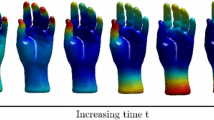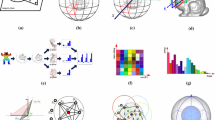Abstract
Effective content-based retrieval in 3D model databases is an important problem that has attracted much research attention over the last years. Many individual methods proposed to date rely on calculating global 3D model descriptors based on image, surface, volumetric, or structural model properties. Descriptors such as these are then input for determining the degree of similarity between models. Traditionally, the ability of individual descriptors to perform effective 3D search is decided by benchmarking. However, in practice the data set on which 3D retrieval is to be applied may differ from the characteristics of the respective benchmark. Therefore, statically determining the descriptor to use based on a fixed benchmark may lead to suboptimal results. We propose a generic strategy to improve the retrieval effectiveness in 3D retrieval systems consisting of multiple model descriptors. The specific contribution of this paper is two-fold. First, we propose to adaptively combine multiple descriptors by forming weighted descriptor combinations, where the weight of each descriptor is decided at query time. Second, we enhance the set of global model descriptors to be combined by including partial descriptors of the same kind in the combinations. Partial descriptors are obtained by applying a given descriptor extractor on the set of parts of a model, obtained by a simple model partitioning scheme. Thereby, more model information is exposed to the 3D descriptors, leading to a more complete object description. We give a systematic discussion of the descriptor combination space involving static and query-adaptive weighting schemes, and based on descriptors of different type and focus (model global vs. partial). The combination of both global and partial model descriptors is shown to deliver improved retrieval precision, compared to policies using single descriptors or fixed-weight combinations. The resulting scheme is generic and can accommodate a large class of global 3D model descriptors.











Similar content being viewed by others
Notes
Other impurity measures are the Gini impurity and the misclassification impurity [15], but we obtained the best experimental results by using entropy impurity.
The original formula introduced in Bustos et al. [6] returned values in the range (0,1]. The new formula presented here ensures that the weight is 0 if the entropy impurity value reaches its maximum.
For the partial descriptors, we let the object segments inherit the class label from their corresponding full model. Entropy Impurity was calculated for each fragment object among all other object fragments from the same spatial index.
References
Akgül CB, Sankur B, Yemez Y, Schmitt F (2008) Similarity score fusion by ranking risk minimization for 3D object retrieval. In: Proc. Eurographics workshop on 3D object retrieval (3DOR’08). Eurographics Association, Aire-la-Ville, pp 41–48
Baeza-Yates R, Ribeiro-Neto B (1999) Modern information retrieval. Addison-Wesley, Reading
Bronstein A, Bronstein M, Bustos B, Castellani U, Crisani M, Falcidieno B, Guibas L, Kokkinos I, Murino V, Sipiran I, Ovsjanikovy M, Patane G, Spagnuolo M, Sun J (2010) Shrec 2010: robust feature detection and description benchmark. In: Proc. Eurographics workshop on 3D object retrieval (3DOR’10). Eurographics Association, Aire-la-Ville, pp 79–86
Bustos B (2006) Index structures for similarity search in multimedia databases. PhD thesis, Department of Computer and Information Science, University of Konstanz
Bustos B, Skopal T (2006) Dynamic similarity search in multi-metric spaces. In: Proc. 8th ACM SIGMM international workshop on multimedia information retrieval (MIR’06). ACM Press, New York, pp 137–146
Bustos B, Keim D, Saupe D, Schreck T, Vranić D (2004a) Automatic selection and combination of descriptors for effective 3D similarity search. In: Proc. IEEE 6th international symposium on multimedia software engineering (ISMSE’04). IEEE Computer Society, New York, pp 514–521
Bustos B, Keim D, Saupe D, Schreck T, Vranić D (2004b) Using entropy impurity for improved 3D object similarity search. In: Proc. IEEE international conference on multimedia and expo (ICME’04). IEEE, New York, pp 1303–1306
Bustos B, Keim D, Saupe D, Schreck T, Vranić D (2005a) Feature-based similarity search in 3D object databases. ACM Comput Surv 37(4):345–387
Bustos B, Keim D, Schreck T (2005b) A pivot-based index structure for combination of feature vectors. In: Proc. 20th annual ACM symposium on applied computing, multimedia and visualization track (SAC-MV’05). ACM Press, New York, pp 1180–1184
Bustos B, Keim D, Saupe D, Schreck T, Vranić D (2006) An experimental effectiveness comparison of methods for 3D similarity search. Int J Digit Libr (Special issue on multimedia contents and management in digital libraries) 6(1):39–54
Bustos B, Keim D, Saupe D, Schreck T (2007) Content-based 3D object retrieval. IEEE Comput Graph Appl (Special issue on 3D documents) 27(4):22–27
Castellani U, Cristani M, Fantoni S, Murino V (2008) Sparse points matching by combining 3D mesh saliency with statistical descriptors. Comput Graph Forum 27(2):643–652
Chen J, Ma R, Su Z (2010) Weighting visual features with pseudo relevance feedback for CBIR. In: Proc. 9th ACM international conference on image and video retrieval (CIVR’10). ACM, New York, pp 220–227
Dalal N, Triggs B (2005) Histograms of oriented gradients for human detection. In: CVPR ’05: Proceedings of the 2005 IEEE Computer Society conference on computer vision and pattern recognition (CVPR’05), vol 1. IEEE Computer Society, Washington, DC, pp 886–893. doi:10.1109/CVPR.2005.177
Duda R, Hart P, Stork D (2001) Pattern classification, 2nd edn. Wiley-Interscience, New York
Frakes W, Baeza-Yates RA (1992) Information retrieval: data structures & algorithms. Prentice-Hall, Englewood Cliffs
Gal R, Cohen-Or D (2006) Salient geometric features for partial shape matching and similarity. ACM Trans Graph 25(1):130–150
Hilaga M, Shinagawa Y, Kohmura T, Kunii T (2001) Topology matching for fully automatic similarity estimation of 3D shapes. In: Proc. ACM international conference on computer graphics and interactive techniques (SIGGRAPH’01). ACM Press, New York, pp 203–212
Iyer N, Jayanti S, Lou K, Kalyanaraman Y, Ramani K (2005) Three-dimensional shape searching: state-of-the-art review and future trends. Comput Aided Design 37:509–530
Jayanti S, Kalyanaraman Y, Iyer N, Ramani K (2006) Developing an engineering shape benchmark for cad models. Comput Aided Design 38(9):939–953
Johnson A, Hebert M (1999) Using spin images for efficient object recognition in cluttered 3D scenes. IEEE Trans Pattern Anal Mach Intell 21(5):433–449
Leng B, Qin Z (2008) A powerful relevance feedback mechanism for content-based 3d model retrieval. Multimed Tools Appl 40(1):135–150
Lou K, Prabhakar S, Ramani K (2004) Content-based three-dimensional engineering shape search. In: Proc. international conference on data engineering (ICDE’04). IEEE Computer Society, New York, pp 754–765
Lowe DG (2004) Distinctive image features from scale-invariant keypoints. Int J Comput Vis 60(2):91–110
Mademlis A, Daras P, Tzovaras D, Strintzis MG (2007) On 3D partial matching of meaningful parts. In: Proc. IEEE international conference on image processing (ICIP’07), vol 2. IEEE, New York, pp 517–520
Marini S, Spagnuolo M, Falcidieno B (2007) Structural shape prototypes for the automatic classification of 3D objects. Comput Graphi Appl 27(4):28–37
Osada R, Funkhouser T, Chazelle B, Dobkin D (2002) Shape distributions. ACM Trans Graph 21(4):807–832
Papadakis P, Pratikakis I, Theoharis T, Passalis G, Perantonis S (2008) 3D object retrieval using an efficient and compact hybrid shape descriptor. In: Proc. Eurographics workshop on 3D object retrieval (3DOR’08). Eurographics Association, Aire-la-Ville, pp 9–16
Rahmani R, Goldman SA, Zhang H, Cholleti SR, Fritts JE (2008) Localized content-based image retrieval. IEEE Trans Pattern Anal Mach Intell 30:1902–1912
Ruggeri M, Saupe D (2008) Isometry-invariant matching of point set surfaces. In: Proc. Eurographics workshop on 3D object retrieval (3DOR’08). Eurographics Association, Aire-la-Ville, pp 17–24
Samet H (2005) Foundations of multidimensional and metric data structures (The Morgan Kaufmann series in computer graphics and geometric modeling). Morgan Kaufmann, San Francisco
Shilane P, Min P, Kazhdan M, Funkhouser T (2004) The Princeton shape benchmark. In: Proc. international conference on shape modeling and applications (SMI’04). IEEE Computer Society, New York, pp 167–178
Sijbers J, Verhoye M, Scheunders P, der Linden AV, Dyck DV, Raman E (1997) Watershed based segmentation of 3D MR data for volume quantization. Magn Reson Imaging 15(6):679–688
Tangelder JWH, Veltkamp RC (2008) A survey of content based 3D shape retrieval methods. Multimed Tools Appl 39(3):441–471
Vranic D (2004) 3D model retrieval. PhD thesis, University of Leipzig, Germany
Vranic D (2005) DESIRE: a composite 3D-shape descriptor. In: Proc. IEEE international conference on multimedia and expo (ICME’05). IEEE, Los Alamitos, pp 962–965
Wessel R, Klein R (2010) Learning the compositional structure of man-made objects for 3d shape retrieval. In: Proc. Eurographics workshop on 3D object retrieval (3DOR’10). Eurographics Association, Aire-la-Ville, pp 39–46
Wessel R, Novotni M, Klein R (2006) Correspondences between salient points on 3D shapes. In: Proc. GI workshop on vision, modeling, and visualization (VMV’06), pp 365–372
Zezula P, Amato G, Dohnal V, Batko M (2005) Similarity search: the metric space approach (Advances in database systems). Springer, Secaucus
Acknowledgements
We thank Dejan Vranić and Dietmar Saupe for providing the base 3D descriptor extractors used in our work. This work was partially funded by the German Research Foundation DFG within the 2010 German-Chile research cooperation program, project number SCHR 1229/2-1.
Author information
Authors and Affiliations
Corresponding author
Rights and permissions
About this article
Cite this article
Bustos, B., Schreck, T., Walter, M. et al. Improving 3D similarity search by enhancing and combining 3D descriptors. Multimed Tools Appl 58, 81–108 (2012). https://doi.org/10.1007/s11042-010-0689-6
Published:
Issue Date:
DOI: https://doi.org/10.1007/s11042-010-0689-6




